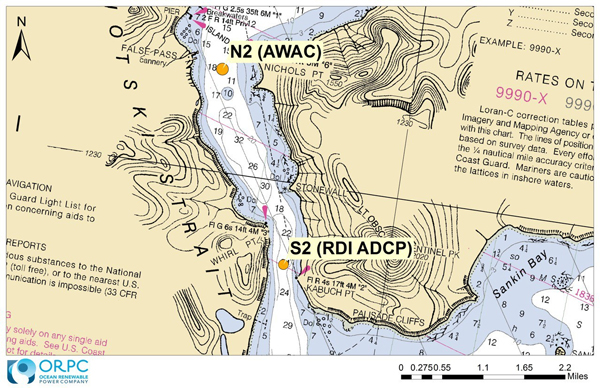
Fishermen and scientists have known for years about the extremely strong ocean currents that rush past the Aleutian town of False Pass. A recent study shows it might be viable as a power source for the town, but there’s still plenty of work to be done.
On its way to the Arctic, frigid water from the Alaska Coastal Current cuts north through Isanotski Strait — the pass that gives “False Pass” its name. Bruce Wright is a scientist with the Aleutian Pribilof Islands Association, and led the team studying the power potential of the straight. They knew the currents would be strong there, but what they found was even better than expected.
“One of the locations, which is in the narrow part of the pass, it has the best tidal resource so far measured in the U.S.,” says Wright.
The water there can surge at up to eight miles per hour. Channeled through an underwater turbine, that could generate enough power for about 200 people — a lot more than the 40 who currently live in False Pass.
In addition to being strong, the currents are also predictable. That’s part of what makes it such an attractive option when compared to other sources of renewable energy.
“The problem with wind is it doesn’t blow all the time,” says Wright. “Some people would say that’s not a problem, but when you’re trying to make electricity from wind, it doesn’t blow all the time, and you get gusts, it’s not steady, so you have to compensate for that.”
That wouldn’t be a problem with ocean power, since it’s possible to map out in advance when currents will gain and lose strength.
But although ocean power looks like an attractive alternative for False Pass, Wright says his team isn’t ready to rework the town’s power grid quite yet. There are plenty of other big questions that need to be answered first — like whether the seafloor can actually support turbines:
“We don’t know what type of structure is on the bottom,” says Wright. “We don’t know what kind of movement there is of rocks, gravel, sand, mud. We don’t know what kind of wildlife is in there. We don’t know if logs are rolling through there.”
During the week of July 22, the team started tracking the movement of debris across the seafloor using sonar arrays funded by the Alaska Energy Authority.
Once that’s done, they’ll use the data to identify the safest place to install a turbine. Then they’ll need to investigate the potential impact to marine life in that area — all while keeping tabs on the currents. And all that research will require a lot more funding than they currently have.
Given the amount of work that’s still ahead, Wright says False Pass is a long way from being powered by the ocean.
“I keep telling these guys we’ll be lucky to pull this off in a decade,” he says.
But can the town afford to wait that long?
“[The] price of diesel is just more and more expensive and stove oil is too,” says city clerk Chris Emrich. “We’re going to have to make it sustainable, we don’t have another choice at this point. That’s why we’re pursuing these other options.”
In addition to ocean power, the town is also looking into wind energy as a way to decrease their reliance on diesel fuel. Neither will be happening in the short-term, but Emrich says the town is happy to be a laboratory.
“[We] don’t have our breaths held it’ll happen,” says Emrich. “But I think it’d be, you know, really good for getting the technology down so it will be more affordable in other villages down the road.”
If the project does come to fruition, False Pass will join Eastport, Maine as the only other town in the country to generate power from ocean currents.




